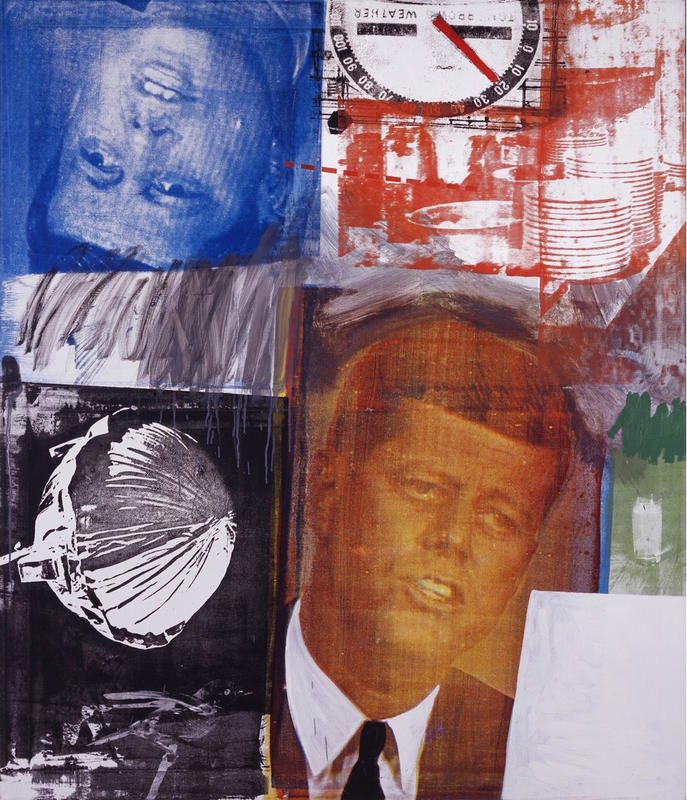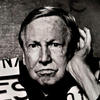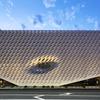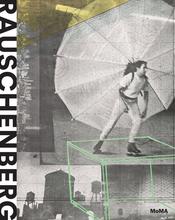More about Untitled
- All
- Info
- Shop

Sr. Contributor
Robert Rauschenberg really loved to throw a bunch of random things together and call it art.
Works like Monogram, which features a taxidermied goat stuck in the middle of an old tire, are a testament to his “anything goes” art-making philosophy. Based on this method, I’m guessing that he would’ve loved those mash-up songs that were really popular in, like, 2010. In the 1950s, Rauschenberg was the King of the Combine – working with images instead of objects seemed to be the next logical step in his impressive oeuvre.
In 1962, Andy Warhol ushered in the next era of Rauschenberg’s career when he introduced Rauschenberg and his then secret lover Jasper Johns to the photo-silkscreen method, and we’re sure glad that he did. Made in 1963, this eerie, JFK-centric silkscreen painting marked a transition in Rauschenberg’s career and his growing interest in experimenting with the process, which he continued to do for the rest of his life. It turns out that JFK was a popular subject for art during this time – Elaine de Kooning painted the president’s portrait in 1962. I guess being “the leader of the free world” will do that for you. For Rauschenberg, the young president symbolized change and the prevailing sense of American progress. The ever-so-dashing JFK appears in many of his silkscreen paintings.
To find material for these silkscreen paintings, Rauschenberg scoured magazines and newspapers for images that he thought would resonate with viewers. Rauschenberg was mining the contemporary collective consciousness and representing it with images, using the media as a jumping-off point. This focus on images probably made his job much easier. Prior to working with just images, Rauschenberg had to discover the found objects that constituted his many Combines, and he usually found the most interesting objects at thrift stores and at the local dump. Rauschenberg still liked to assert the handmade nature of these silkscreen paintings, which he did by inserting his own brushstrokes onto each of these canvases. This combination of found images with his own hand reminds me a little bit of that Sandra Lee cooking show, Semi-Homemade.
After about a year of working in the photo-silkscreen medium, Rauschenberg won the holy grail of contemporary art world contests – the grand prize for foreign artist at the Venice Biennale. This win initiated a huge turn in the global art scene. For the first time, the United States, not Europe, was officially the “it” place for new art production.
At this time, Rauschenberg also just put on three extremely successful museum and gallery exhibitions. This sudden surge of fame and the pressure to create new and groundbreaking work must have gone to his head a little bit because, shortly after the Biennale win, Rauschenberg called up his assistant in his New York studio to destroy all of the images that he had been using to create his photo-silkscreens. He still kept making these silkscreen paintings, but he wanted to make sure that he wasn’t reusing the same images too often, even if using images of JFK made his paintings consistently feature a really cute guy.
Sources
- Arnason, H.H., and Elizabeth C. Mansfield. History of Modern Art. 7th ed. Upper Saddle River, NJ: Pearson Education, Inc., 2013.
- Fineberg, Jonathan. Art Since 1940: Strategies of Being. Upper Saddle River, NJ: Pearson Education, Inc., 2011.
- La Biennale di Venezia. 1964: The rise of Pop Art, 2017. http://www.labiennale.org/en/art/history/pop_art.html. Accessed July 18, 2017.
- Solomon R. Guggenheim Foundation. Untitled. Robert Rauschenberg. Collection Online. https://www.guggenheim.org/artwork/3519. Accessed July 19, 2017.
- The Broad. Robert Rauschenberg. Art. https://www.thebroad.org/art/robert-rauschenberg. Accessed July 18, 2017.












